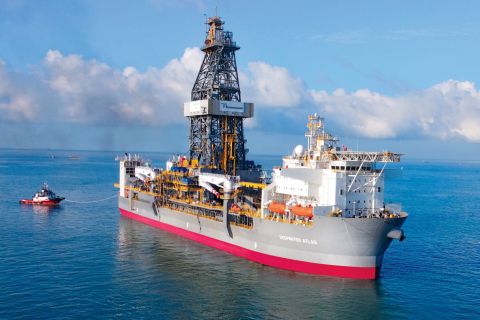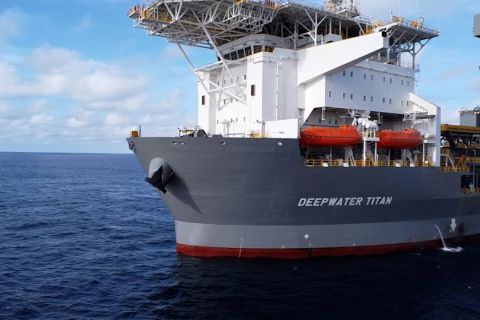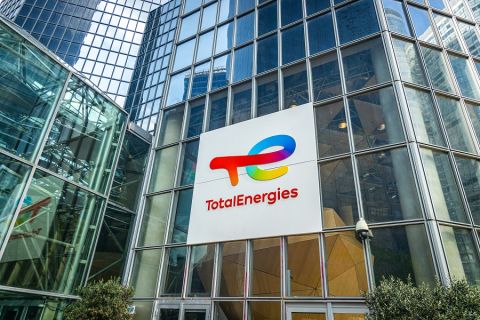
Lake Charles LNG faces regulatory hurdles, Energy Transfer executives said during its second-quarter earnings call. (Source: Shutterstock)
Energy Transfer set records in transport volumes during the second quarter but could not escape the market trend of lower commodity prices eating into earnings.
“Our volume growth was more than offset by significantly lower quarterly average natural gas and NGL prices, which declined 70% and 45%, respectively, over the second quarter of last year,” Tom Long, co-CEO, told analysts during the quarterly earnings call on Aug. 2.
Adjusted second-quarter EBITDA of $3.12 billion was down by $110 million from the same period last year, the company said. Distributable cash flow was $1.55 billion versus $1.88 billion last year.
While the company reported a steady performance and continued growth, executives said they remain focused on the Lake Charles LNG project in Louisiana and overcoming regulatory hurdles from the Department of Energy.
The Lake Charles project would create a large-scale export facility on the Calcasieu Ship Channel. The plan is to convert Energy Transfer’s current Lake Charles LNG import terminal to an export facility. The project allows Energy Transfer to take advantage of an abundant natural gas supply and proximity to significant pipeline infrastructure in the area.
Last summer, the Federal Energy Regulatory Commission approved an extension on the completion of the project to December 2028. Energy Transfer followed that with an application to the Department of Energy for a deadline extension to commence export.
In April, the request was denied. In June, the department rejected the request for a rehearing of the denial.
“We’ve worked pretty hard on this project,” said co-CEO Mackie McCrea, detailing how the project slowed down during the COVID-19 shutdowns and then picked back up after the war in Ukraine started. “We had tremendous momentum, signed up a lot—8 million or 9 million tons—developed relationships all around the world, really good relationships.”
The Department of Energy’s decision has “cut the legs out from under them,” McCrea said. However, Energy Transfer already has three major customers who have signed non-binding agreements with three customers for 3.6 million metric tons per year. Long said the customers are Chesapeake and Gunvor, EQT and a Japanese firm.
RELATED
Chesapeake Energy, Gunvor Sign 15-year LNG Agreement for Haynesville Gas
McCrea said there was a positive feeling that Energy Transfer would be able to move forward. Another meeting with the federal agency is scheduled for the upcoming week.
“We’re being optimistic that they’ll work with us to … go down this new path that we’re going down to try to get an export authorization approved by them,” he said.
Focus on growth
Along with the Lake Charles project negotiations, the company has been focused on growth.
Last quarter, Energy Transfer reached a final investment decision to expand its NGL export capacity at its Nederland, Texas, terminal by up to 125,000 bbl/d, in a project expected to cost $1.25 billion with service starting in mid-2025. The project is needed to respond to long-term growth in international demand, Long said.
In the Delaware Basin, the company put its eighth 200 MMcf/d processing plant into service in June, with another plant under consideration.
The growth will continue as the company has consistently had to wrestle with high demand over the last year.
The company recorded crude oil transportation volumes for the quarter at a record 5.3 MMbbl/d, compared to 4.3 MMbbl/d for the same period last year. Most of the higher volumes came on Energy Transfer’s Texas pipeline systems, Long said.
Company leadership also discussed the progression of its Lotus acquisition. On May 2, Energy Transfer announced a $1.45 billion acquisition of Lotus Midstream Operations and its network of crude oil pipelines stretching from New Mexico through the Permian Basin and into Oklahoma. The networks are still merging, and the new owners are still finding ways to exploit the new lines.
“… We’ve just closed it (Lotus’ network), and our crude team gets excited every week about something new,” McCrea said. “Some new routes, some new blending opportunities, some new additions that we can add to move more throughput on some areas we didn't think about.”
Overall, NGL fractionation volumes increased by 5%, NGL transportation volumes rose 13% and midstream gathered volumes grew by 8%—all setting company records. According to a company statement, interstate natural gas transportation volumes rose 17%, crude transportation by 23% and terminal volumes were up 15%.
“In total, we continue to export more NGLs than any other company and maintain approximately 20% market share of worldwide NGL exports as well as nearly 40% of U.S. exports,” Long said.
Recommended Reading
E&P Highlights: March 4, 2024
2024-03-04 - Here’s a roundup of the latest E&P headlines, including a reserves update and new contract awards.
Rystad: More Deepwater Wells to be Drilled in 2024
2024-02-29 - Upstream majors dive into deeper and frontier waters while exploration budgets for 2024 remain flat.
E&P Highlights: Feb. 26, 2024
2024-02-26 - Here’s a roundup of the latest E&P headlines, including interest in some projects changing hands and new contract awards.
After 4Q Struggles, Transocean’s Upcycle Prediction Looks to Pay Off
2024-02-21 - As Transocean executives predicted during third-quarter earnings, the company is in the middle of an upcycle, with day rates and revenues reaching new heights.
Cronos Appraisal Confirms Discovery Offshore Cyprus
2024-02-15 - Eni-operated block partner TotalEnergies says appraisal confirms the presence of significant resources and production potential in the block.




